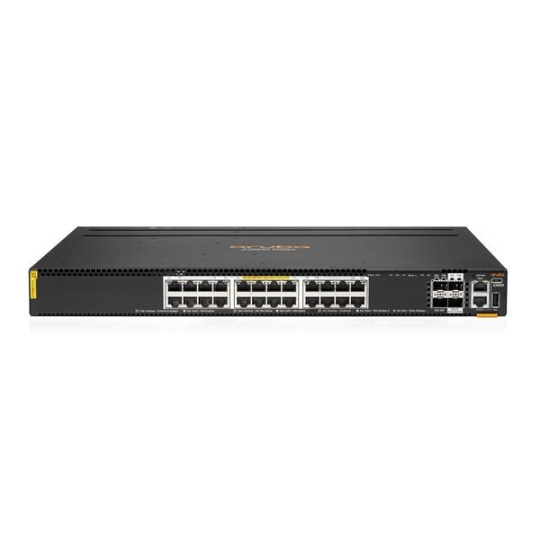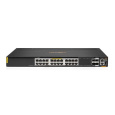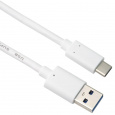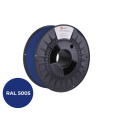HPE Aruba Networking CX 6300M 24p Smart Rate 1G/2.5G/5G/10G Class6 PoE 2p 50G 2p 25G Switch
HPE Aruba Networking CX 6300M 24p Smart Rate 1G/2.5G/5G/10G Class6 PoE 2p 50G 2p 25G Switch
HPE Aruba Networking CX 6300M 24p Smart Rate 1G/2.5G/5G/10G Class6 PoE 2p 50G 2p 25G Switch
- Must Select PSU Min1 / Max2 (680W JL086A,1050W JL087A, 1600W JL670A, 1050W JL758A) Mix OK
- Includes Fantrays Min2 / Max 2 (JL669B)
- Min=0 \ Max = 2 SFP+/SFP28 10/25 Transceiver (Ports 25/26)
- Min=0 \ Max = 2 SFP+/SFP28/SFP56 10/25/50G Transceiver (Ports 27/28)
- 1U - Height
Key Features
- Stackable Layer 3 switches with BGP, EVPN, VXLAN, VRF, and OSPF with robust security and QoS
- High performance 880 Gbps system switching capacity, 660 MPPS of system throughput and up to 200 Gbps stacking bandwidth (400 Gbps at full duplex)
- Compact 1U switches with full density HPE Smart Rate (1G/2.5G/5G/10GbE) multi-gigabit, up to 90W PoE (Class 8) and 10G LRM SFP+ available on select models
- Power-to-port switch bundle with back-to-front airflow ideal for data center 1GbE ToR and OOBM deployments
- Built-in high speed 1/10/25/50GbE uplinks1
- 50GbE connectivity with 50GbE DACs1
- Intelligent monitoring, visibility, and remediation with Aruba Network Analytics Engine
- Manage via single pane of glass with Aruba Central across wired, wireless, and WAN
- Aruba NetEdit support for automated configuration and verification
- Aruba Dynamic Segmentation enables secure and simple access for users and IoT
Notes: 150G capability is for use with 50G DACs for both interconnect and VSF stacking. 50G SR transceivers have been added with a minimum software of 10.09.1010. VSF stacking not supported on 1G ports.
| Aruba 6300M 24-port SFP+ and 4-port SFP56 Switch (R8S89A) | ||
| Description | 24x ports SmartRate 100M/1G/2.5G/5G/10G BaseT Class 6 PoE ports supporting up to 60W per port (MACsec) 2x 10G/25G/50G1 SFP ports 2x 10G/25G SFP ports (MACsec) Supports PoE Standards IEEE 802.3af, 802.3at and 802.3bt (up to 60W) 1x USB-C Console Port 1x RJ Console Port 1x OOBM port 1x USB Type A Host port 1x Bluetooth dongle to be used with CX Mobile App Notes: 150G capability is for use with 50G DACs for both interconnect and VSF stacking. 50G SR transceivers have been added with a minimum software of 10.09.1010. VSF stacking not supported on 1G ports. | |
| Power Supplies | 2 field-replaceable, hotswappable power supply slots 1 minimum power supply required (ordered separately)
Supported PSUs JL086A JL087A JL670A JL758A Max PoE Power: 2880W | |
| Fans | Switch has two fan tray slots and comes with two fan trays installed. Min 2 fan trays required. Fan trays are field replaceable and hotswappable. Each fan tray contains two fans. | |
| Physical Characteristics | Dimensions | (H) 4.4 cm x (W) 44.2 cm x (D) 38.5 cm (1.73" x 17.4" x 15.2") |
| Weight | 5.26 kg (11.60 lbs) | |
| Mounting and Enclosure | Mounts in an EIA- standard 19 in. telco rack or equipment cabinet. Horizontal surface mounting only. 2-post rack kit included. | |
| Additional Specifications | CPU | Quad Core ARM CortexTM A72 @ 1.8GHz |
| Memory and Flash | 8 GB DDR4 32 GB eMMC | |
| Packet Buffer | 16 MB | |
| Performance | System switching capacity | 880 Gbps |
| System throughput capacity | 660 Mpps | |
| Model switching capacity | 880 Gbps | |
| Model throughput capacity | 654 Mpps | |
| Average latency (LIFO, 64-byte packets) | 1Gbps: 4.24µSec 10Gbps: 1.50µSec 25Gbps: 2.91µSec 50Gbps1: 3.49µSec Notes: 150G capability is for use with 50G DACs for both interconnect and VSF stacking. 50G SR transceivers have been added with a minimum software of 10.09.1010. VSF stacking not supported on 1G ports. | |
| Stack size | 10 members | |
| Max stacking distance | Up to 10 kms with long range transceivers | |
| Stacking bandwidth | 200 Gbps | |
| Switched virtual interfaces (dual stack) | 1,024 | |
| IPv4 host table (ARP) | 49,152 | |
| IPv6 host table (ND) | 49,152 | |
| IPv4 unicast routes | 61,000 | |
| IPv6 unicast routes | 61,000 | |
| IPv4 multicast routes | 8,192 | |
| IPv6 multicast routes | 8,192 | |
| MAC table capacity | 32,768 | |
| IGMP groups | 8,192 | |
| MLD groups | 8,192 | |
| IPv4/IPv6/MAC ACL entries (ingress) | 20,480/5,120/20,480 | |
| IPv4/IPv6/MAC ACL entries (engress) | 8,192/2,048/8,192 | |
| VFR | 256 | |
| Environment | Operating temperature | 32°F to 113°F (0°C to 45°C) up to 5,000 ft. Derate -1 degree C for every 1,000 ft from 5,000 ft to 10,000 ft. Can support excursion to 131°F (55°C) for short periods1 of time. 55C excursion not supported when 10G LRM/LR/ER inserted:
Notes: 150G capability is for use with 50G DACs for both interconnect and VSF stacking. 50G SR transceivers have been added with a minimum software of 10.09.1010. VSF stacking not supported on 1G ports. |
| Operating relative humidity | 15% to 95% @ 104°F (40°C) non-condensing | |
| Non-operating temperature | -40°F to 158°F (-40°C to 70°C) up to 15,000 ft | |
| Non-operating humidity | 15% to 90% @ 149°F (65°C) non-condensing | |
| Max operating altitude | 10,000 feet (3.04 km) Max | |
| Max non-operating altitude | 15,000 feet (4.6 km) Max | |
| Acoustic | Sound Power, LWAd = 4.9 Bel Sound Pressure, LpAm (Bystander) = 33.0 dB | |
| Primary airflow | Front and side-to-back | |
| Electrical Characteristics | Frequency | 50Hz/60Hz |
| AC voltage | JL670A PSU: 110V-120V/208V-240V JL086A PSU: 100V-240V JL087A PSU: 110V-240V | |
| Current (for voltages listed above) | JL670A PSU: 11A/8A JL086A PSU: 8A/3.5A JL087A PSU: 12A/5A | |
| Power consumption (230VAC) | With JL086A PSU: Idle: 90W 100% Traffic Rate: 143W Idle: 90W 100% Traffic Rate: 140W With JL670A PSU: Idle: 101W 100% Traffic Rate: 152W | |
| Safety | Include US, Canada, Europe, Worldwide | Europe: EN 62368-1:2014 +A11:2017 2nd Ed. EN 62368-1:2020 +A11:2020 3rd Ed. UK: BS EN 62368-1:2014 + A11:2017 2nd Ed BS EN 62368-1:2020 + A11:2020 3rd Ed US/Canada: UL 62368-1 2nd Ed. CAN/CSA-C22.2 No. 62368-1-14 2nd Ed. Worldwide: IEC 60950-1:2005 + Am1:2009 + Am2:2013 w/all known National Deviations IEC 62368-1:2014 2nd Ed. w/all known National Deviations IEC 62368-1:2018 3rd Ed. w/all known National Deviations |
| Emissions | Include US, Canada, Europe, Worldwide | Europe: EN 55032:2015 +A11:2020, Class A EN 55035:2017 +A11:2020 EN 61000-3-2:2014, Class A EN 61000-3-3:2013 US/Canada: FCC CFR47 Part 15:2014, Class A ICES-003 Class A Worldwide: VCCI Class A CISPR 32 Class A CISPR 35:2016 |
| Lasers | Include US, Canada, Europe, Worldwide | EN 60825-1:2014 / IEC 60825-1:2014 Class 1 Class 1 Laser Products / Laser Klasse 1 (Applicable for accessories - Optical Transceivers only) |
| Immunity | Generic | CISPR 35 |
| EN | EN 55035:2017 | |
| ESD | IEC 61000-4-2 | |
| Radiated | IEC 61000-4-3 | |
| EFT/Burst | IEC 61000-4-4 | |
| Surge | IEC 61000-4-5 | |
| Conducted | IEC 61000-4-6 | |
| Power frequency magnetic field | IEC 61000-4-8 | |
| Voltage dips and interruptions | IEC 61000-4-11 | |
| Harmonics | IEC 61000-3-2, EN 61000-3-2 | |
| Flicker | IEC 61000-3-3, EN 61000- 3-3 | |
| Mounting and Enclosure | Mounts in an EIAstandard 19 in. telco rack or equipment cabinet. Horizontal surface mounting only. 2-post rack kit included. | |
The HPE Aruba Networking CX 6300 Switch Series is a modern, flexible and intelligent family of stackable switches ideal for enterprise network access, aggregation, core and data center top of rack (ToR) deployments. Created for game- changing operational efficiency with built-in security and resiliency, the 6300 switches provide the foundation for high-performance networks supporting IoT, mobile and cloud applications.
Built from the ground up with a combination of cutting-edge hardware, software and analytics and automation tools, the stackable 6300 switches are part of the Aruba CX switching portfolio, designed for today's enterprise campus, branch and data center networks. By combining a modern, fully programmable OS with the Aruba Network Analytics Engine, the 6300 switches provide industry leading monitoring and troubleshooting capabilities for the access layer.
A powerful Aruba Gen7 ASIC architecture delivers performance and robust feature support with flexible programmability for tomorrow's applications. The Aruba Virtual Stacking Framework (VSF) allows for stacking of up to 10 switches, providing scale and simplified management. This flexible series has built-in wirespeed 1/10/25/50GbE uplinks and supports high density IEEE 802.3bt high power PoE. HPE Smart Rate multi-gigabit Ethernet paves the way for high speed access points and IoT devices by delivering fast connectivity and high power PoE using existing cabling. Modular models offer redundancy and PoE customization with hot-swappable power supplies and fans. Back-to-front airflow available in switch bundle for hot-cold aisle top-of-rack (TOR) and out-of-band-management (OOBM) data center deployments.
Aruba Dynamic Segmentation extends Aruba's foundational wireless role-based policy capability to Aruba wired switches. What this means is that the same security, user experience and simplified IT management can be enjoyed throughout the network. Regardless of how users and IoT devices connect, consistent policies are enforced across wired and wireless networks, keeping traffic secure and separate.
Standard Features
| AOS-CX - A Modern Operating System The HPE Aruba Networking CX 6300 Switch Series is based on AOS-CX, a modern, database-driven operating system that automates and simplifies many critical and complex network tasks.
A built-in time series database enables customers and developers to utilize software scripts for historical troubleshooting, as well as analysis of past trends. This helps predict and avoid future problems due to scale, security, and performance bottlenecks AOS-CX operating system features are organized into Aruba CX Foundation and Aruba CX Advanced software licenses. Every Aruba CX switch includes an active, embedded Aruba CX Foundation license at no additional cost with the option to upgrade to an Aruba CX Advanced license. The CX Foundation license has everything needed to deploy, connect, and troubleshoot an enterprise network, including:
The Aruba CX Advanced license includes Aruba CX Edge Insights, offering deep visibility with application recognition, identification, and flow capture from layer 4 to layer 7. For more information on the CX Advanced License, read the Aruba CX Switch License Ordering Guide Because AOS- CX is built on a modular Linux architecture with a stateful database, our operating system provides the following unique capabilities:
|
| Aruba Central - Unified Single Pane of Glass Management Aruba Central is an AI-powered solution that simplifies IT operations, improves agility, and reduces costs by unifying management of all network infrastructure. Built for enterprise-grade resiliency and security, while simple enough for smaller businesses with limited IT staff, Aruba Central is your single point of visibility and control that spans the entire network --from branch to data center, wired and wireless LAN to WAN. Available as a cloud-based or on-premises solution, Aruba Central is designed to simplify day zero through day two operations with streamlined workflows for tasks such as virtual switch stack creation, automated monitoring using AI-powered insights and NAE, as well as a unified view of all devices and users, both wired and wireless. Comprehensive switch management capabilities include configuration, on-boarding, monitoring, troubleshooting, and reporting. An Aruba Central Foundation license subscription enables comprehensive switch management capabilities that include configuration, onboarding, monitoring, troubleshooting, and reporting. An Aruba Central Advanced license expands these capabilities with premium security and AIOps, including the Aruba Central NetConductor Fabric Wizard and Policy Manager to enable dynamic segmentation and distributed enforcement at a global scale. With the Aruba Central Advanced license there is no need to purchase a CX Advanced license. This streamlines operational efficiency, reducing the need for your IT team to keep track of multiple licenses, active terms, and renewal dates. For more information on Aruba Central licensing, see the Aruba Central SaaS Subscription Ordering Guide. |
| Aruba Network Analytics Engine - Advanced Monitoring and Diagnostics For enhanced visibility and troubleshooting, Aruba's Network Analytics Engine (NAE) automatically monitors and analyzes events that can impact network health. Advanced telemetry and automation provide the ability to easily identify and troubleshoot network, system, application and security related issues easily, through the use of python agents, CLI-based agents, and REST APIs. The Time Series Database (TSDB) stores configuration and operational state data, making it available to quickly resolve network issues. The data may also be used to analyze trends, identify anomalies and predict future capacity requirements. |
| Aruba NetEdit - Automated Switch Configuration and Management The entire Aruba CX portfolio empowers IT teams to orchestrate multiple switch configuration changes for smooth end-to-end service rollouts. Aruba NetEdit introduces automation that allows for rapid network-wide changes, and ensures policy conformance post network updates. Intelligent capabilities include search, edit, validation (including conformance checking), deployment and audit features. Capabilities include:
Notes: A separate software license is required to use Aruba NetEdit. |
| Aruba CX Mobile App - True Deployment Convenience An easy to use mobile app simplifies connecting and managing HPE Aruba Networking CX 6300 Switch Series for any size project. Switch information can also be imported into Aruba NetEdit for simplified configuration management and to continuously validate the conformance of configurations anywhere in the network. The Aruba CX Mobile App is available for download. |
| Aruba Asics - Programmable Innovation Based on over 30 years of continuous investment, Aruba's ASICs create the basis for innovative and agile software feature advancements, unparalleled performance and deep visibility. These programmable ASICs are purpose-built to allow for a tighter integration of switch hardware and software within campus and data center architectures to optimize performance and capacity. Virtual Output Queuing (VOQ) isolates congestion prevents Head of Line Blocking (HOLB) and allows full line rate on outgoing (egress) ports. Flexible ASIC resources enable Aruba's NAE solution to inspect all data, which allows for industry-leading analytics capabilities. The HPE Aruba Networking CX 6300 Switch Series is based on the Aruba Gen7 ASIC architecture. |
| Aruba Dynamic Segmentation - Campus and Branch Fabric The Aruba Dynamic Segmentation solution enables seamless mobility, consistent policy enforcement, and automated configurations for wired and wireless clients across networks of all sizes. And it extends these benefits to applications hosted on the data center and the public cloud. This innovation begins with colorless ports and role-based micro-segmentation technologies. Colorless ports allows wired clients to connect to any switch port, with the configuration automated using Radius-Based Access Control. This eliminates the need for manual on-boarding of clients, including IoT devices, onto the network. Role-based micro-segmentation delivers benefits of reduced subnet and VLAN sprawl, simplified policy definition, and scales policy enforcement by introducing the concept of client User Roles. These roles are independent of network constructs such as VLANs and VRFs, and allows clients to be grouped into a User Role based on their identity. This allows the colorless ports technology to be extended to the overlay fabric, as clients are on-boarded with automatic tunnel creation based on the associated User Role policy. The User Role policy also offers the choice between micro-segmentation with a Layer 4 Role-Role ACL on switches or a Layer 7 stateful firewall enforcement. Dynamic Segmentation provides much needed scale and flexibility in network design by allowing the stretching of VLANs and subnets across the entire network. Fabric overlays offer VXLAN or VXLAN-GBP tunnels on the data plane and provide the option of a Multi-Protocol BGP eVPN control plane for large deployments, or a static Layer 2 control plane for simplified deployments. Dynamic Segmentation also eliminates the complexity of service-chaining and redirection of traffic to 3rd party firewalls. User Role Policy can steer client's traffic on overlay tunnels (User Based Tunnels) to Aruba's Policy Enforcement Firewall for deep-packet inspection and application aware Layer 7 stateful firewall filtering. After performing this stateful inspection for any security threats, the traffic is automatically put back on the VXLAN fabric to be delivered to its destination. |
| Mobility and IoT Performance The HPE Aruba Networking CX 6300 Switch Series uses a fully distributed architecture that utilizes the Aruba Gen7 ASICs. This ensures that our switches offer very low latency, increased packet buffering, and adaptive power consumption. All switching and routing are wire-speed to meet the demands of bandwidth-intensive applications today and in the future. Each switch includes the following:
Notes: 150G capability is for use with 50G DACs for both interconnect and VSF stacking. 50G SR transceivers have been added with a minimum software of 10.09.1010. VSF stacking not supported on 1G ports. |
| VSF Stacking - Scale and Simplicity The Aruba Virtual Switching Framework (VSF) allows you to quickly grow your network using high performance front plane stacking. Additional features include:
|
| Quality Of Service (Qos) Features To support congestion actions and traffic prioritization, the HPE Aruba Networking CX 6300 Switch Series includes the following:
|
| An HPE Aruba Networking CX 6300 Switch Series Switch for Any Enterprise Environment Whether in the branch office or a small to large enterprise environment, you can choose from 24 and 48 ports of HPE Smart Rate Multi-Gigabit. Each switch includes four high-speed built-in uplinks that auto-negotiate from 1GbE, 10GbE to 50GbE1 to deliver non-blocking performance. Fixed format (F) models include built-in power supplies. The modular (M) models have rear slots for hot swappable power supplies that allow you to customize your PoE requirements, and its fans are field replaceable. Additional highlights:
24 and 48 ports of HPE Smart Rate Multi-gigabit Ethernet IEEE 802.3bz (100M/1GbE/2.5GbE/5GbE/10GbE) supporting high power IEEE 802.3bt Class 6 (60W) to Class 8 (90W) High density 24 port SFP+ model which is ideal for aggregation 1/10/25/50GbEuplink1 port connectivity
IPv6 host enables switches to be managed in an IPv6 network Dual stack (IPv4 and IPv6) transitions from IPv4 to IPv6, supporting connectivity for both protocols MLD snooping forwards IPv6 multicast traffic to the appropriate interface IPv6 ACL/QoS supports ACL and QoS for IPv6 network traffic IPv6 routing supports Static and OSPFv3 protocols Security provides RA guard, DHCPv6 protection, dynamic IPv6 lockdown, ND snooping, IPv6 Destination Guard, IPv6 DHCP Guard, and IPv6 Router Advertisement Guard
Notes: 150G capability is for use with 50G DACs for both interconnect and VSF stacking. 50G SR transceivers have been added with a minimum software of 10.09.1010. VSF stacking not supported on 1G ports. |
| High Availability and Resiliency To ensure a high degree of up-time we offer high availability and multicast features needed for a full Layer 3 deployment at access and aggregation such as PBR, BFD, MSDP, BSR, and IP SLA without the need for software licenses. This includes:
Provides N+1 and N+N redundancy for high reliability in the event of power line or supply failures Optional secondary power supplies to increase the total available PoE power Fixed power supplies in 6300 "F" models
|
| CX 6300M Bundle for Data Centers The CX 6300M 48 port power-to-port switch bundle serves as a top of rack (ToR) switch for 1GbE servers and also as a 1GbE out-of-band management (OOBM) switch for data centers server racks. Features include:
Notes: 150G capability is for use with 50G DACs for both interconnect and VSF stacking. 50G SR transceivers have been added with a minimum software of 10.09.1010. VSF stacking not supported on 1G ports. |
| Simplified Configuration and Management In addition to Aruba Central, the Aruba CX Mobile App, Aruba NetEdit and Aruba Network Analytics Engine, the 6300 series offers the following:
|
| Layer 2 Switching The following layer 2 services are supported:
|
| Layer 3 Services The following layer 3 services are supported:
|
| Multicast
|
| Visibility Customers can choose to upgrade the active, embedded CX Foundation license to the term-based CX Advanced license to unlock the following benefits for their business:
|
| Security The HPE Aruba Networking CX 6300 Switch Series come with an integrated trusted platform module (TPM) for platform integrity. This ensures the boot process started from a trusted combination of Aruba AOS-CX switches. Other security features include:
|
| Layer 3 Routing The following layer 3 routing services are supported:
|
| Convergence
|
| Additional information
|
| Customer First, Customer Last Support When your network is important to your business, then your business needs the backing of Aruba Support Services. Partner with Aruba product experts to increase your team productivity, keep pace with technology advances, software releases, and obtain break-fix support.
For complete details on Foundation Care and Aruba Pro Care, please visit: https://www.arubanetworks.com/supportservices/ |
| Warranty, Services and Support
|
.




